
HOME
1/14th Daily
Journals for JUNE 1966.
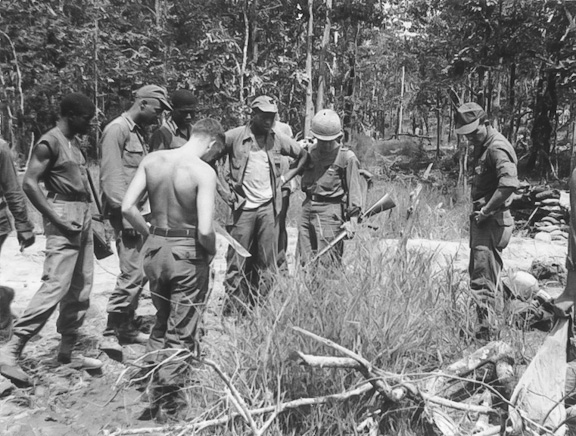
End of a Snake . . . in LZ 27D
1 thru 4 JUNE 1966
Company C closed into LZ 27D to pick up Company Bís responsibility of
manning ten OP points. The emplacement of these points ran east to west on
the northern slopes to the Chu Pong Mountain complex, then started running
due north across the Ia Drang River for approximately 5,000 meters.
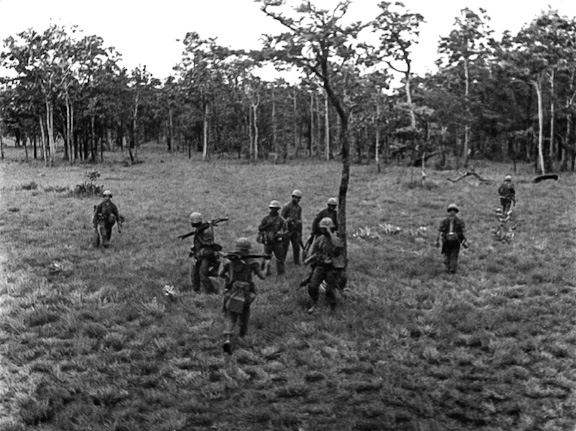
C/1/14 troops vicinity the "Dew Line" near the Cambodian border
The Dragons were now involved in a surveillance
type mission Ė one they had yet to encounter. The tactical displacement of
this mission required a static company base. From here the platoons moved
out to their respective sectors. At a central location and one of easy
recognition by their own men, a platoon base was established. From this
location fire team size OP groups moved out to their preplanned post. The
major function of the Platoon base was that of immediate reaction for any
engaged OP point and also to cover any one of these pointís route of
withdrawal. Major Evrard made it explicit that the mission of these points
was to detect the enemy and to call in effective indirect fire on his
location but not to engage the enemy unless the post had been compromised
and the enemy puts effective fire on the position.
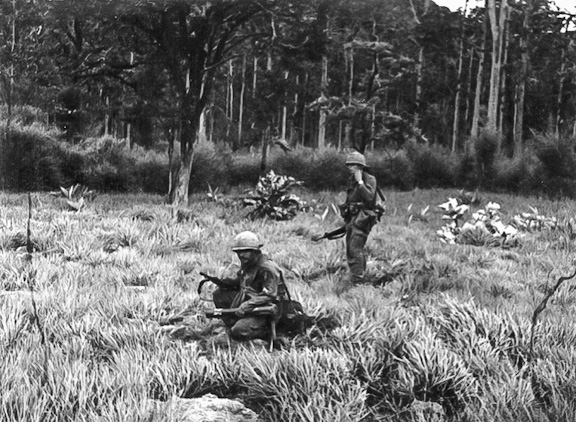
C Co soldiers in vicinity of Chu Pong in the Ia Drang Valley
Company A was also located at LZ 27D, which was
located about 1100 meters north of the Ia Drang River. Company A and Company
D would alternate the task of the surveillance mission every three days
while the Company unengaged would act as the command group security and also
rear reaction force.
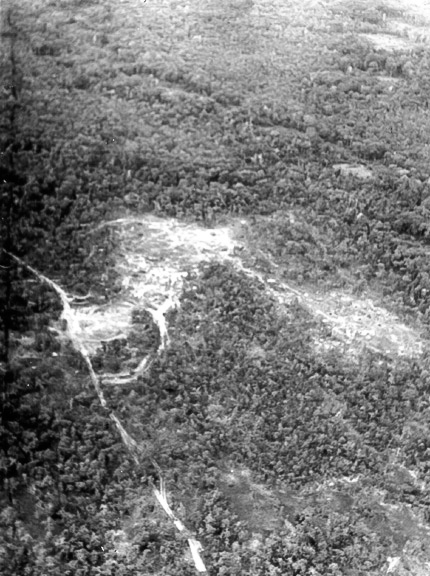
One of the major difficulties the Dragons encountered working in the valley
area was the problem of crossing the swollen river and streams lacing the
area. Located to the southeast of LZ 27D was the hazardous Ia Drang River,
which had to be traversed daily in order to maintain an effective
surveillance of the area. Extensive use of ropes and floating devices were
used to cross these natural obstacles.
Company B moved to a location at the Oasis with the 69th Armor conducting search and destroy type missions in its immediate vicinity. The RRU units detected enemy communications in some of the friendly villages to the west and north of the Oasis.
During this four day period, the rains pelted down hours at a time and the men began to realize that the rainy season in Vietnam was not just a fable.
5 thru 7 JUNE 1966 early on the morning of the 5th, the Dragons received word that they would prepare for a new mission. With Company B of the 2nd Battalion, 35th Infantry relieving Company C in place, Company C moved back to LZ 27D to rejoin Company A.
It is ironic to mention here that while the Dragons were in the area for about six days they detected no enemy movement of any type. However, one hour after Company B of the 2nd Battalion, 35th Infantry relieved our Company C in place they became immediately engaged with an enemy force of undetermined size. Many of the men could not understand how they could avoid the enemy after such a detailed saturated effort in the area. The conclusion was, "Charlie" is afraid of the Dragons. This seemed at the time rather humorous, but many of the men gave it a second thought.
C Companyís elements closed into LZ 27D, where they joined Company A for the remainder of the evening. Both A Company and C Company were lifted to the Oasis to receive further instruction on their new mission.
The day of the 7th was utilized in taking hot showers and getting into clean clothes. Hot A rations were served at two meals and were both a welcome change. The night was quiet and the troops were able to get some well-earned sleep.
8 JUNE 1966 the Dragons were now attached to the 2nd Brigade of the 1st Air Cav. for an operation to the north of Highway 19. With the 2nd Brigade on the right flank and the Dragons on the left flank the combined force would sweep from about 25,000 meters northwest of Oasis to the highway. Also each Battalion would put on of its companies just north of the highway as a blocking position. Company A and Company C would be the sweeping elements for the Dragons while Company B would act as the blocking force.
With clear skies on the morning of the 8th, Company C made a combat assault into LZ 5B with negative contact. After Company C had closed with all its elements, A Company commenced its assault into LZ 5C. Captain Armstrong coordinated with Captain Ross and both units spread its flanks and moved out. Each unit had common phase lines, which made control of movement possible.
At approximately 1300 hours C Companyís 3rd Platoon spotted a Montagnard dressed in NVA clothing. When ordered to halt, the man tried to flee and was shot and killed. After the immediate area was searched, there was found one NVA pack containing clothes and about 600 rounds of 7.62 short ammunition.
After the incident, both units continued their search and clear mission through some extremely thick and mountainous terrain. Both units stopped about 1700 hours to set up their perimeter at night. After the defensive concentrations were called in, the night was quiet.
9 JUNE 1966 early in the morning, Colonel Procter received word that the 2nd Bde of the 1st Air Cav. would be detached from the 3rd Bde to assume another mission. Thus, General Walker told Colonel Procter, if at all possible, this mission should close as soon as possible. With rugged mountainous terrain ahead of them, the Dragons pushed on. The area showed few signs of any activity and the trek was tiring to those in the best of condition. As the units started to approach the highway they began to leave the high ground and work their way through tall elephant grass that ripped their clothing and cut their skin. This stretch also included hazardous swamps that were difficult to navigate. About 1700 hours, both units had reached the highway, the men exhausted. Waiting for the Brigades was a convoy that carried them back to the Oasis for hot A rations and a well-earned rest.
10 JUNE 1966 was
spent in preparation for tomorrowís operation, which will require the
Dragons to move into a different area of operation.
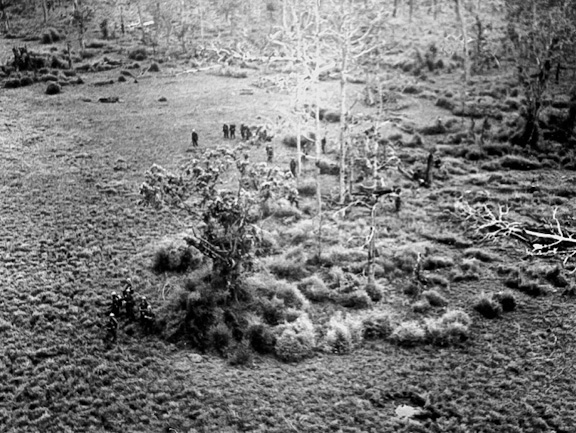
Troops awaiting helicopter pickup near
base of Chu Pong Mtn.
11 JUNE 1966 the battalion commenced the operation with several combat assaults. The Recon Platoon and the Command Group went into LZ 29B followed by Company C into LZ 37K and Company A into 28E. Negative enemy contact was reported in all assaults and A and C Companies immediately commenced search and destroy operations in their area of responsibility.
Company B meanwhile moved overland from the Oasis with the Scout Platoon of the 69th Armor. About 2 km from their starting point, one of the tanks hit a mine, two men were injured but not seriously. At 0925 hours, B Company dismounted from the tanks about 20 kís north of LZ 29B and the tanks returned to the Oasis. Company B ran into extremely thick underbrush.
Early in the afternoon Company B discovered what appears to be a way station consisting of approximately 126 huts, and many assorted dug in positions. The unit also found and destroyed five of eight pigs and twelve chickens. All crops and huts were destroyed. Company B left a stay-behind force to ambush the area. Even though Company B huffed and puffed, three little pigs escaped.
Company A reported evidence of previous enemy activity in their area of operation.
12 JUNE 1966 the night proved to be a quiet one. At 0729 hours C Companyís 1st and 2nd Platoons helicopter lifted into an area and started search and destroy operations. They both reported negative contact. Later in the morning Company C requested a medevac for two men.
Company A sent patrols into their area of operations. The 3rd Platoon reported negative contact and closed into LZ 28E at 1200 hours. The 1st Platoon reported numerous punji stakes and traps.
Company B continued searching their area with negative contact.
13 JUNE 1966 at 0920 Company Cís 3rd Platoon reported sighting two VC. They were unable to maintain contact because of the rough terrain. While trying to establish contact again, they discovered and destroyed five hoochs.
Company Aís 2nd Platoon made contact with three VC. They killed one and pursued the other two. One enemy pack was captured, but no weapons.
Later in the afternoon Company Cís weapons platoon found and destroyed 20 bundles of punji stakes.
Company Aís 3rd Platoon spotted two VC entering their position. The VC turned and went away. The platoon laid low to see if the VC would return. They didnít.
14 JUNE 1966 early in the morning the forward command group reported what was believed to be 8 to 10 mortar rounds landing near their perimeter. It was learned a short time later that one of Company Bís positions had noticed movement to their front and had one hand grenade thrown into their location. They returned fire with M-16s and M-79s. The M-79 rounds were what landed near the command groupís position. No injuries were reported and the rest of the night proved quiet.
At 0830 Company B discovered 17 recently occupied hooches. They had been hit by rocket fire.
Company Bís 3rd Platoon moved into a village, but reported negative contact.
Company Aís 3rd Platoon found several punji stakes and fresh cooked rice. Company Aís 1st Platoon encountered six VC. They wounded three and captured one weapon. They pursued the fleeing enemy, but were unable to establish contact because of the thick underbrush.
Company Bís 3rd Platoon located 22 hooches, 14 bunkers and 5 holes. They flushed one VC, but he slipped away when they fired upon him. They dispatched a squat to search for the escaped VC. Meanwhile they searched the area and found 2 Russian type magazines, 1 NVA pack, 30 pounds of rice, 2 pair of sandals and 1 US Army antenna.
Company C reported one of their elements found a cache including 1 TA 312 Phone, 1 broken radio, 5 rifle grenades, 5 AT rockets, 5 hand grenades and a small amount of 7.62 ammunition. All units settled for the night and reported negative enemy contact.
15 JUNE 1966 about 1200 hours Company Cís weapons platoon found a possible NVA regimental CP consisting of bunkers and about two tons of rice. After this discovery, they proceeded to destroy the rice.
Later in the afternoon, they also found a VC company size bivouac area. Several bundles of punji stakes were destroyed. They continued with search and discovered another similar bivouac area. They estimated that it had been occupied one to two weeks ago. They found old canvas equipment including several packs and ammunition pouches.
All units settled for what proved to be another quiet night.
16 JUNE 1966 the day began with an extremely low ceiling and visibility was rather limited. At 0900 hours the weather began to break and the whirl of the choppers could soon be heard. Company A and the Command Group were helilifted into LZ 52K with negative contact. Both Companies B and C completed their moves and settled in their new locations with negative contact.
17 JUNE 1966 at early light, Company A and Company C moved out on search and destroy operations in their respective areas.
Company Aís 1st Platoon spotted three VA fleeing to the west. They pursued, but lost contact at a nearby waterfall.
Company Cís 1st Platoon remaining in AO 29, as a stay-behind force sprung an ambush and killed four VC. One VC (WIA) escaped. The platoon was commanded by 2/Lt. Perry Royston.
Company Bís 1st Platoon reported they were pursuing five to seven VC, but lost contact in the heavy underbrush. 2/Lt. Frank Primmer commanded this platoon.
18 JUNE 1966 Company
Bís third platoon discovered 17 huts, 1500-1700 pounds of rice, 2 knives
15-17 inches long, several bundles of punji stakes and several Vietnamese
documents, one pertaining to physical training exercises.
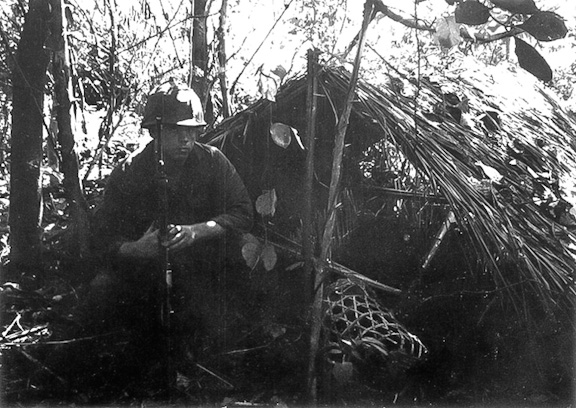
The 2nd Platoon of Company C, commanded by 2/Lt. Richard Murphy,
found 2 huts, 100 pounds of cotton, fresh meat, vegetables and fruit. The
trail leading into this area was covered with punji stakes. The 2nd
Platoon of Company B found 1 hut half full of rice. Near this hut they found
a river crossing (rope bridge). After crossing the river they came across
another hut and several bamboo baskets.
19 JUNE 1966 Company B, while en-route to their new location discovered a well-prepared enemy position consisting of 39 bunkers with good cover. They also found one NVA pack and one 5 pound bomb that looked to be of an aerial type.
Brigade S2 notified Colonel Procter that the 2nd Battalion, 35th Infantry was in contact with a platoon size element of NVA troops. All units of the Golden Dragons were notified to be especially alert for possible enemy activity during the night.
Company A (minus one platoon) and the Command Group walked into LZ 52A for the night. One platoon of Company A went into LZ 52K; Company C at LZ 52L. There was negative contact during the night.
20 JUNE 1966 the day was a quiet one for the Dragons but Brigade reported Company A, 2nd Battalion, 35th Infantry reported a series of small contacts. No further information was obtained.
Company B moved into a clearing where they could be extracted by chopper on the following day.
All supporting elements at the Oasis spent the day in preparation for the move to a new location near the Plei Me Special Forces Camp. This new area was designated WAIKIKI.
21 JUNE 1966 Company C moved out at daybreak on search and destroy missions.
At 1030 hours the Forward CP began their motor move from the Oasis to WAIKIKI. At 1530 hours, all elements closed into the new location. The elephant grass was 6 to 8 feet high and the units already at that location could hardly be located. Danny Dragon, the Battalion Mascot, was quite enraged when they tied him to a tree located in the high grass. He didnít care for WAIKIKIís environment. The original WAIKIKI was never like this.
22 JUNE 1966 today Major Evrard retired as our Battalion S3 and was assigned new duties as the Battalion Executive Officer. While Major Evrard performed as the S3 he showed the men the true aggressiveness and spirit of the Golden Dragons.
We gained a new member to the Dragon Clan, Captain Raymond E Johnson, formally with the 1st Battalion, 35th Infantry (Cacti, as their S3 air). Captain Johnson would henceforth perform the function as the new Dragon S3.
Major Robert Levergood, our Battalion XO was assigned to the job of Brigade S1.
23 JUNE 1966 the battalion moved into AO 53. After an artillery preparation Company C made a combat assault into LZ 53D (ZV070850) with no enemy contact. They were followed by the 4.2 mortar platoon and the Command Group. As soon as the mortars were set up they began firing preparations on LZ 53B (ZV020863) prior to Company Aís assault. This enabled A Btry, 2/9th Arty to prepare for and begin their lift to LZ 53D. Company A closed with no enemy contact. After a 4.2 preparation Company B went into LZ 53F (ZV043837) with no enemy contact. The Battalion Recon and Security platoons remained at LZ 52A (YV995895) to provide security until the Artillery had cleared. They were then lifted to LZ 53D. As soon as the Artillery was in position the 4.2 platoon was lifted to Company Bís position at LZ 53F. A Company began searching its AO with negative contact except for spotting two OP huts in trees. Company C had one platoon land at coordinates ZV095895 and they screened south along the Ya Gle River to LZ 53D. They found several OP huts in trees and had secondary explosions when they forced M-79 rounds into them. Ambushes were set out by each company.
24 JUNE 1966 the battalion today competed screening AO 53. Each company accomplished this task by sending out platoon size patrols on search and destroy missions. There was no enemy contact during the day. One patrol from Company A found an enemy observation post and some fresh footprints, but no sightings were made. The highlight of the day was real ice cream from the land of the Big P X flown into the Golden Dragons by Captain Silvola.
25 JUNE 1966 the battalion was prepared bright and early to move to AO 54, however due to poor weather the move was postponed for one day until 26 June. The rains poured down the entire day and most of the men stayed under their ponchos and wrote home to their loved ones.
26 thru 30 JUNE 1966 these following days were rather uneventful for the Golden Dragons. The weather continued to show no mercy on the men with the rains pouring almost constantly from the darkened skies.
Saturation type patrolling was executed. All units reported negative contact the with invisible enemy. The men seemed to be close to him yet not close enough to effectively subdue him. Patrol reports showed the finding of burning campsites and in some instances half-cooked rice. "Charlie" was in the area and the men knew it, but finding him would be a task that only time would accomplish. Fresh tracks, well used trails, recently built huts, bivouac areas, and even recently lost equipment were all signs telling the Dragons the time would come.
AO 54, where the men were operating was characterized by all types of terrain that was offered by the Pleiku Plateau Region. The men encountered thick underbrush as well as the ripping and skin shredding elephant grass. The earth would no longer absorb the pelting rains thus creating an ocean of mud and water that became in time an endurance test for the mind as well as the body.
On the 29th of June Captain Russell Ware received command of Company B from Captain Richard Barry, who went to 3rd Brigade to assume the position of Assistant S1.
